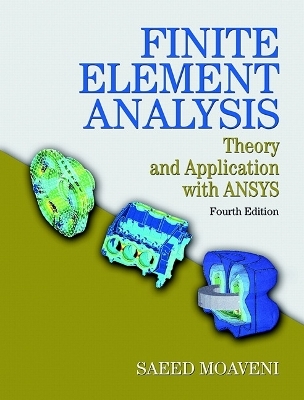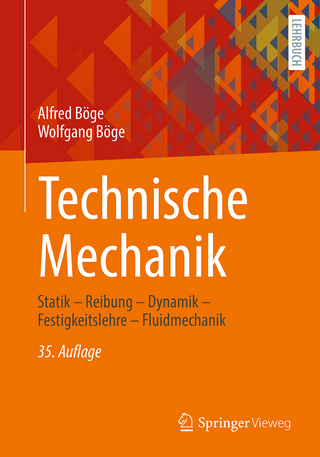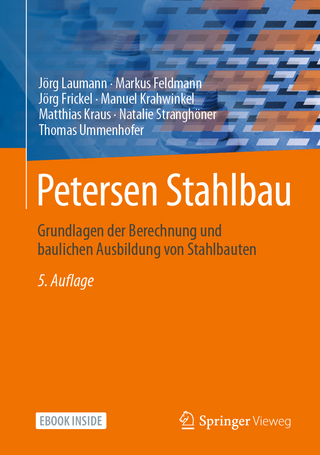
Finite Element Analysis
Pearson (Verlag)
978-0-13-384080-3 (ISBN)
- Titel erscheint in neuer Auflage
- Artikel merken
While many good textbooks cover the theory of finite element modeling, Finite Element Analysis: Theory and Application with ANSYS is the only text available that incorporates ANSYS as an integral part of its content. Moaveni presents the theory of finite element analysis, explores its application as a design/modeling tool, and explains in detail how to use ANSYS intelligently and effectively.
Teaching and Learning Experience
This program will provide a better teaching and learning experience—for you and your students. It will help:
Present the Theory of Finite Element Analysis: The presentation of theoretical aspects of finite element analysis is carefully designed not to overwhelm students.
Explain How to Use ANSYS Effectively: ANSYS is incorporated as an integral part of the content throughout the book.
Explore How to Use FEA as a Design/Modeling Tool: Open-ended design problems help students apply concepts.
Preface xi
Acknowledgments xv
1 Introduction 1
1.1 Engineering Problems 2
1.2 Numerical Methods 5
1.3 A Brief History of the Finite Element Method and ANSYS 6
1.4 Basic Steps in the Finite Element Method 6
1.5 Direct Formulation 8
1.6 Minimum Total Potential Energy Formulation 37
1.7 Weighted Residual Formulations 43
1.8 Verification of Results 48
1.9 Understanding the Problem 49
Summary 54
References 54
Problems 54
2 Matrix Algebra 66
2.1 Basic Definitions 66
2.2 Matrix Addition or Subtraction 69
2.3 Matrix Multiplication 69
2.4 Partitioning of a Matrix 73
2.5 Transpose of a Matrix 77
2.6 Determinant of a Matrix 81
2.7 Solutions of Simultaneous Linear Equations 86
2.8 Inverse of a Matrix 94
2.9 Eigenvalues and Eigenvectors 98
2.10 Using MATLAB to Manipulate Matrices 102
2.11 Using Excel to Manipulate Matrices 106
Summary 120
References 121
Problems 121
3 Trusses 125
3.1 Definition of a Truss 125
3.2 Finite Element Formulation 126
3.3 Space Trusses 151
3.4 Overview of the ANSYS Program 153
3.5 Examples Using ANSYS 161
3.6 Verification of Results 193
Summary 195
References 195
Problems 195
4 Axial members, Beams, and Frames 205
4.1 Members Under Axial Loading 205
4.2 Beams 213
4.3 Finite Element Formulation of Beams 218
4.4 Finite Element Formulation of Frames 234
4.5 Three- Dimensional Beam Element 240
4.6 An Example Using ANSYS 242
4.7 Verification of Results 267
Summary 269
References 270
Problems 271
5 One- Dimensional Elements 283
5.1 Linear Elements 283
5.2 Quadratic Elements 287
5.3 Cubic Elements 289
5.4 Global, Local, and Natural Coordinates 292
5.5 Isoparametric Elements 294
5.6 Numerical Integration: Gauss–Legendre Quadrature 296
5.7 Examples of One- Dimensional Elements in ANSYS 301
Summary 301
References 301
Problems 301
6 Analysis of One- Dimensional Problems 308
6.1 Heat Transfer Problems 308
6.2 A Fluid Mechanics Problem 327
6.3 An Example Using ANSYS 331
6.4 Verification of Results 346
Summary 347
References 347
Problems 348
7 Two- Dimensional Elements 351
7.1 Rectangular Elements 351
7.2 Quadratic Quadrilateral Elements 355
7.3 Linear Triangular Elements 360
7.4 Quadratic Triangular Elements 365
7.5 Axisymmetric Elements 369
7.6 Isoparametric Elements 374
7.7 Two- Dimensional Integrals: Gauss—Legendre Quadrature 377
7.8 Examples of Two- Dimensional Elements in ANSYS 378
Summary 379
References 379
Problems 380
8 More Ansys 387
8.1 ANSYS Program 387
8.2 ANSYS Database and Files 388
8.3 Creating a Finite Element Model with ANSYS: Preprocessing 390
8.4 h- Method Versus p- Method 404
8.5 Applying Boundary Conditions, Loads, and the Solution 404
8.6 Results of Your Finite Element Model: Postprocessing 407
8.7 Selection Options 412
8.8 Graphics Capabilities 413
8.9 Error- Estimation Procedures 415
8.10 An Example Problem 417
Summary 431
References 432
9 Analysis of Two- Dimensional Heat Transfer Problems 433
9.1 General Conduction Problems 433
9.2 Formulation with Rectangular Elements 440
9.3 Formulation with Triangular Elements 451
9.4 Axisymmetric Formulation of Three- Dimensional Problems 470
9.5 Unsteady Heat Transfer 477
9.6 Conduction Elements used by ANSYS 487
9.7 Examples Using ANSYS 488
9.8 Verification of Results 528
Summary 528
References 530
Problems 530
10 Analysis of Two- Dimensional Solid Mechanics Problems 542
10.1 Torsion of Members with Arbitrary Cross- Section Shape 542
10.2 Plane- Stress Formulation 558
10.3 Isoparametric Formulation: Using a Quadrilateral Element 566
10.4 Axisymmetric Formulation 573
10.5 Basic Failure Theories 575
10.6 Examples Using ANSYS 576
10.7 Verification of Results 598
Summary 598
References 600
Problems 600
11 Dynamic Problems 609
11.1 Review of Dynamics 609
11.2 Review of Vibration of Mechanical and Structural Systems 623
11.3 Lagrange’s Equations 640
11.4 Finite Element Formulation of Axial Members 642
11.5 Finite Element Formulation of Beams and Frames 651
11.6 Examples Using ANSYS 665
Summary 684
References 684
Problems 684
12 Analysis of Fluid Mechanics Problems 691
12.1 Direct Formulation of Flow Through Pipes 691
12.2 Ideal Fluid Flow 703
12.3 Groundwater Flow 709
12.4 Examples Using ANSYS 712
12.5 Verification of Results 733
Summary 734
References 735
Problems 736
13 Three- Dimensional Elements 741
13.1 The Four- Node Tetrahedral Element 741
13.2 Analysis of Three- Dimensional Solid Problems Using Four- Node
13.3 The Eight- Node Brick Element 749
13.4 The Ten- Node Tetrahedral Element 751
13.5 The Twenty- Node Brick Element 752
13.6 Examples of Three- Dimensional Elements in ANSYS 754
13.7 Basic Solid- Modeling Ideas 758
13.8 A Thermal Example Using ANSYS 769
13.9 A Structural Example Using ANSYS 786
Summary 799
References 799
Problems 799
Tetrahedral Elements 744
14 Design and Material Selection 808
14.1 Engineering Design Process 809
14.2 Material Selection 812
14.3 Electrical, Mechanical, and Thermophysical Properties of Materials 813
14.4 Common Solid Engineering Materials 815
14.5 Some Common Fluid Materials 822
Summary 824
References 824
Problems 824
15 Design Optimization 826
15.1 Introduction to Design Optimization 826
15.2 The Parametric Design Language of ANSYS 830
15.3 Examples of Batch Files 832
Summary 843
References 844
Problems 844
Appendix A mechanical Properties of some materials 845
Appendix B thermophysical Properties of some materials 848
Appendix C Properties of Common line and Area shapes 849
Appendix D Geometrical Properties of structural steel shapes 852
Appendix e Conversion Factors 856
Appendix F An introduction to mAtlAB 858
index 893
| Erscheint lt. Verlag | 3.4.2014 |
|---|---|
| Sprache | englisch |
| Maße | 10 x 10 mm |
| Gewicht | 1275 g |
| Themenwelt | Technik ► Bauwesen |
| Technik ► Maschinenbau | |
| ISBN-10 | 0-13-384080-8 / 0133840808 |
| ISBN-13 | 978-0-13-384080-3 / 9780133840803 |
| Zustand | Neuware |
| Informationen gemäß Produktsicherheitsverordnung (GPSR) | |
| Haben Sie eine Frage zum Produkt? |
aus dem Bereich



